Pasty Recipe
This pasty recipe is a classic dish that’s been around for generations, offering a warm, hearty meal wrapped in a crispy, golden crust.
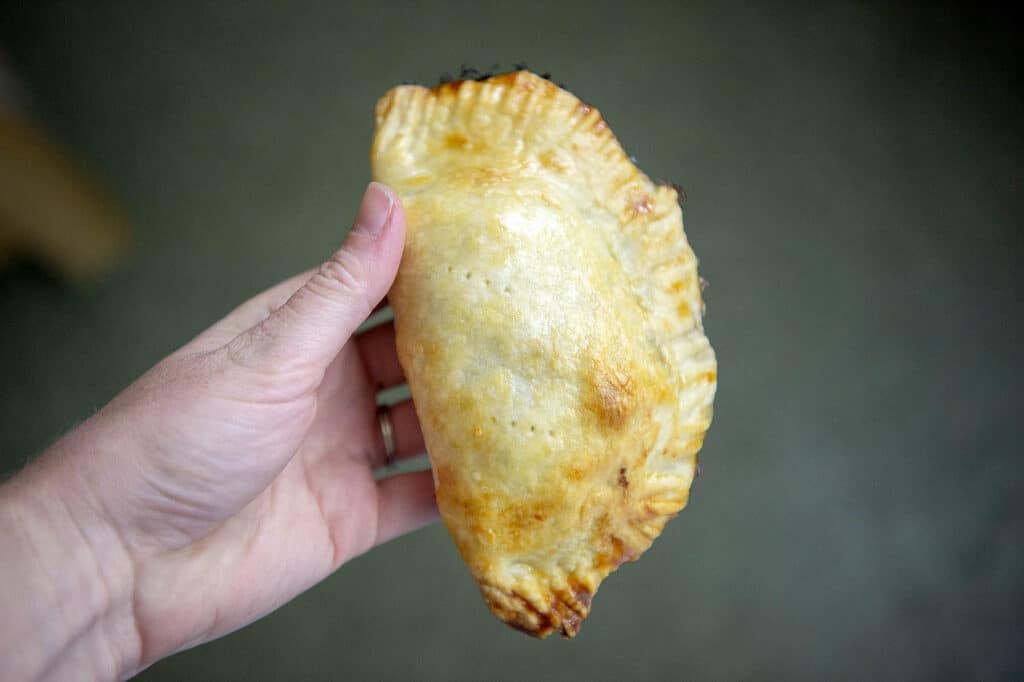
Originating in Cornwall, England, and traditionally filled with meat, vegetables, and a bit of seasoning, it’s become a popular comfort food for many.
This version features a buttery crust and a filling of ground beef, pork, and a medley of root vegetables that will leave you feeling full and satisfied. While pasties are often thought of as a humble meal, they’re perfect for feeding the family or packing up for a picnic or lunch on the go.
What Makes This So Great?
What sets pasties apart from other hand-held pies or turnovers is their simplicity. They’re an all-in-one meal, with a sturdy dough that holds up to a variety of fillings. Pasties are versatile, meaning you can change up the ingredients based on what you have on hand. Whether you’re a fan of classic beef and pork or want to explore vegetarian or other dietary-friendly options, this recipe can be easily adjusted to suit your tastes.

Pasties are also a meal-prepper’s dream. You can make a big batch, freeze them, and have easy-to-reheat meals ready to go for busy days. With this recipe, you’re getting a balanced dish of protein, vegetables, and carbs, all wrapped up in a portable, filling crust.
What Kitchen Items Do You Need To Make This?
While making pasties is relatively simple, you will need a few key kitchen tools to ensure your dough and filling come together seamlessly. Here’s what you’ll need:
- Large Mixing Bowl: For mixing both the dough and the filling.
- Wooden Spoon: Helpful for stirring the dough as you incorporate the boiling water.
- Rolling Pin: Essential for rolling out the dough into flat circles for wrapping the filling.
- Fork: You’ll need this for crimping the edges of the dough and poking holes in the pasties before baking.
- Baking Sheet: To place the assembled pasties on before baking. Lining the sheet with parchment paper will help prevent sticking and make cleanup easier.
- Pastry Brush: This is used to brush the egg wash onto the tops of the pasties, giving them that beautiful golden-brown crust.
- Small Bowl of Water: Necessary for sealing the edges of the dough.
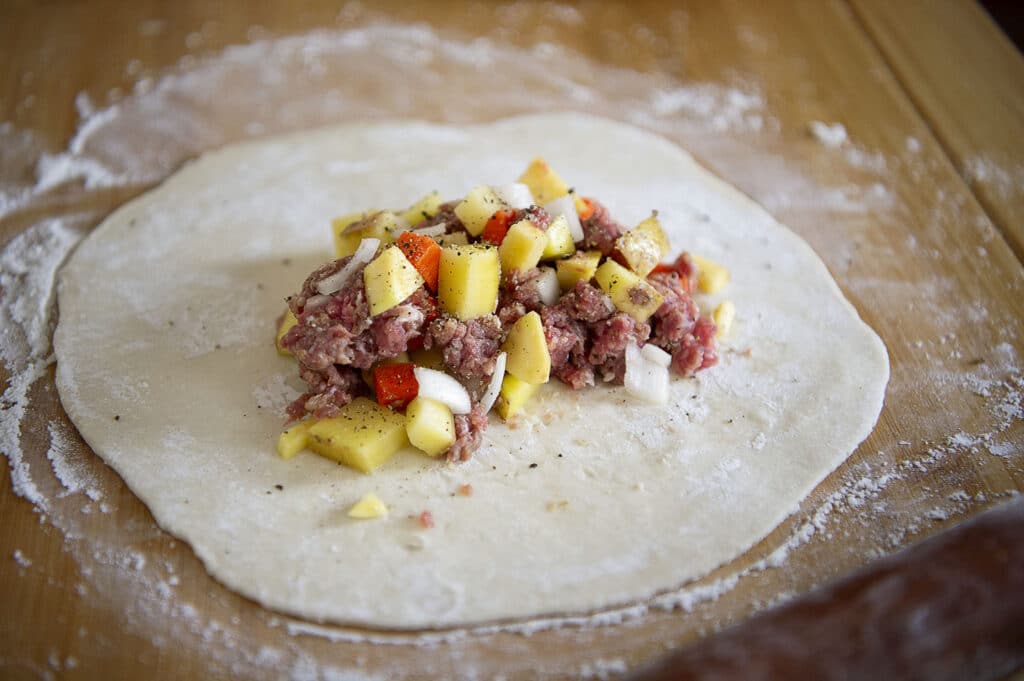
What Ingredients Are Needed For This Recipe?
This pasty recipe uses a simple list of ingredients, many of which you might already have in your pantry and fridge. You don’t need to get fancy with additional ingredients—just focus on the basics for a hearty and delicious meal.
For the Crust:
- 3 cups all-purpose flour (plus more for rolling out the dough)
- 1 tsp kosher salt
- 11 tbsp unsalted butter (cold, cut into small pats)
- 1½ cups boiling water
- 1 egg, beaten (for the egg wash)
For the Filling:
- ½ lb ground beef
- ½ lb ground pork
- 1 medium white onion, finely chopped
- 1 medium potato, finely chopped
- 2 carrots, finely chopped
- 1 medium rutabaga, finely chopped
- Butter, for adding to the filling
- Salt and pepper, to taste
How To Make It
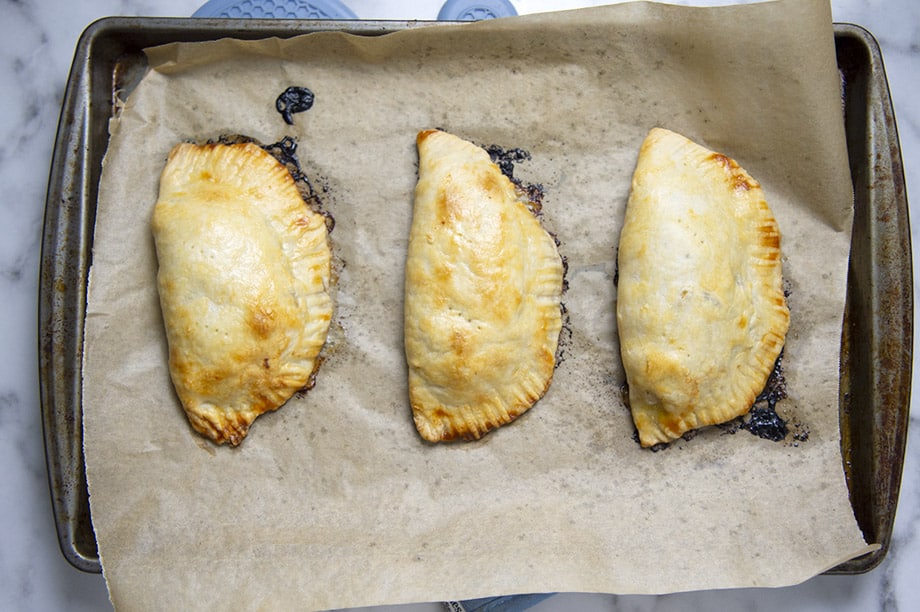
For the Dough:
- Mix the dough: Start by combining the flour and salt in a large mixing bowl. Next, cut your cold butter into small pats and add it to the flour mixture. Using your hands, work the butter into the dough until it has a crumbly texture.
- Add water: Carefully pour the boiling water into the dough mixture. Use a wooden spoon to mix until the dough starts to come together. The dough will initially look sticky, but as you knead it, it will turn into a smooth ball.
- Knead and rest: Once the dough starts forming, turn it out onto a lightly floured surface and knead for 3-5 minutes until it’s soft and no longer sticky. If it’s still too sticky, sprinkle a little more flour. Once you’ve kneaded it, divide the dough into 4 balls, cover them with plastic wrap, and set them in the fridge while you prepare the filling.
For the Filling:
- Prepare the filling: In a medium-sized mixing bowl, combine the ground beef, ground pork, chopped onion, potato, carrots, and rutabaga. Season the mixture generously with salt and pepper. Use your hands to mix everything together, breaking up the meat into small pieces so that it’s evenly distributed throughout the vegetables.
To Assemble and Bake:
- Roll out the dough: Take one ball of dough from the refrigerator and cut it in half. Set one half aside. On a lightly floured surface, roll out the dough into a circle roughly 6 inches in diameter.
- Fill the pasty: Preheat your oven to 375°F. Scoop about ½ to ¾ cup of the filling onto the rolled-out dough, slightly off-center. Season the filling with more salt and pepper, then place a small pat of butter on top of the filling.
- Seal the pasty: Dip your finger in the small bowl of water and wet the edge of the dough. Fold the dough over the filling and press the edges together. Use a fork to crimp the edges, sealing the filling inside.
- Prepare for baking: Place the assembled pasties on a parchment-lined baking sheet. Use a fork to gently poke two small holes in each pasty to allow steam to escape during baking. Brush each pasty with a light layer of the beaten egg.
- Bake: Bake the pasties in your preheated oven for 45 minutes, or until the crust is golden brown. Once done, remove them from the oven and let them cool for 10 minutes before serving.
If you plan to freeze some of the pasties, do so at this stage before baking. Wrap them individually in plastic wrap and place them in a freezer-safe bag. When you’re ready to cook them, simply bake them from frozen, adding an additional 10-15 minutes to the bake time.

What Is the History Behind This Recipe?
Pasties have a rich history, particularly in Cornwall, England, where they were originally made for miners. The idea was to create a sturdy, hand-held meal that could be eaten without utensils, even in the dirty conditions of the mines. The miners would hold the crust, eat the filling, and then discard the crust, which would often become soiled with dirt or soot.
The pasty was a practical solution to the problem of needing a filling meal that could be easily transported. Over time, the pasty has evolved and become popular in various regions, particularly in the Upper Peninsula of Michigan, where they were brought over by Cornish immigrants. Today, pasties are enjoyed in different parts of the world, often with slight variations in the filling based on local preferences.
What Can I Switch Up To Make This Different If I Have Dietary Needs?
One of the great things about pasties is how adaptable they are. If you have dietary restrictions, it’s easy to make a few changes to suit your needs:
- Vegetarian: If you’re avoiding meat, simply swap out the ground beef and pork for a vegetarian protein, like lentils, black beans, or a meat substitute. You can also add more vegetables, like mushrooms or spinach, for additional texture.
- Vegan: To make this recipe vegan, substitute the butter in both the crust and the filling with a plant-based alternative. For the egg wash, you can use a little bit of plant-based milk to brush the tops of the pasties for browning.
- Gluten-Free: To make gluten-free pasties, use a gluten-free flour blend to make the dough. Keep in mind that gluten-free dough can be a bit more delicate, so you may need to handle it carefully when rolling it out.
Alternative Names and Similar Dishes
- Alternative Names: In different regions, pasties may be referred to by other names. For example, in the American Midwest, they are sometimes simply called “hand pies.”
- Region or State: While pasties are traditionally associated with Cornwall, they have become a beloved dish in places like Michigan and Wisconsin, where Cornish immigrants settled.
- Similar Dishes: If you like pasties, you might also enjoy empanadas, which are a similar hand-held pie found in Latin American cuisine. Samosas, a popular Indian street food, also share similarities with pasties in their dough-wrapped filling format.
How Should I Store This?
Pasties are perfect for meal prepping because they store well both in the fridge and freezer. Here’s how to store them for later:
- Refrigerating: If you have leftover pasties, store them in an airtight container in the fridge. They’ll keep for up to 3 days. To reheat, you can pop them in the oven at 350°F for about 10-15 minutes, or until warmed through.
- Freezing: If you want to freeze the pasties for a longer shelf life, assemble them but don’t bake them. Freeze them on a baking sheet first, then transfer them to a freezer-safe bag once they’re solid. When you’re ready to eat, bake them from frozen at 375°F, adding an extra 10-15 minutes to the cooking time.
- 3 cups all purpose flour plus more for rolling
- 1 tsp kosher salt
- 11 tbsp unsalted butter
- 1½ cups boiling water
- 1 egg beaten in a small bowl
- ½ lb ground beef
- ½ lb ground pork
- 1 medium white onion finely chopped
- 1 medium potato finely chopped
- 2 carrots finely chopped
- 1 medium rutabaga finely chopped
- butter
- salt and pepper
- Mix the flour and salt in a large mixing bowl. Cut the butter into pats and add it to the flour. Using your hands, work the butter into the dough until it's combined. It should be crumbly.
- Carefully add your boiling water into the dough mixture. Mix to combine using a wooden spoon. It will be sticky and look like mashed potatoes but then transition to a very smooth dough.
- When it starts coming together as a dough, turn out onto a lightly floured surface. Knead until soft about 3 – 5 minutes. (If it's still very sticky, add a little more flour and incorporate). Separate into 4 balls. Cover with plastic wrap and place in the fridge while you prepare the filling.
- In a medium sized mixing bowl, add all of your chopped veggies, ground beef, and ground pork. Season liberally with salt and pepper.
- Mix together the meat and veggies, breaking up the meat into small pieces.
- Take your dough out from the refrigerator. On a lightly floured surface, take one of the balls and cut in half. Set the half aside. Roll the dough out into a roughly 6'' circle. Have a small bowl of water set off to the side.
- Preheat oven to 375℉. Scoop filling mixture (about ½ – ¾ cup) on top of the dough, slightly off center. Season with salt and pepper and place a small pat of butter on top. Dip your finger in the bowl of water and we the edge of the dough where it will fold over and connect. Fold the dough over onto the wet edge and crimp the crust. Repeat this step until all the dough is used.
- Use a fork to gently poke each pasty twice to allow. Then use a brush to brush the egg wash all over the tops and sides of the pasties. *(If you want to freeze some for later, do so now and follow freeze instructions below).
- Line a baking sheet with parchment paper and add pasties. Bake at 375℉ for 45 minutes, or until golden brown. Remove from heat and let cool for 10 minutes. Enjoy.

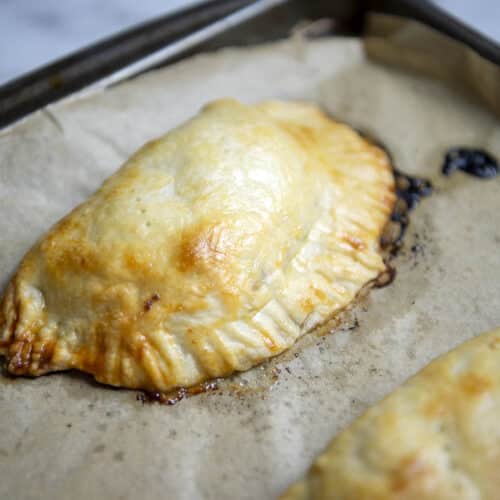
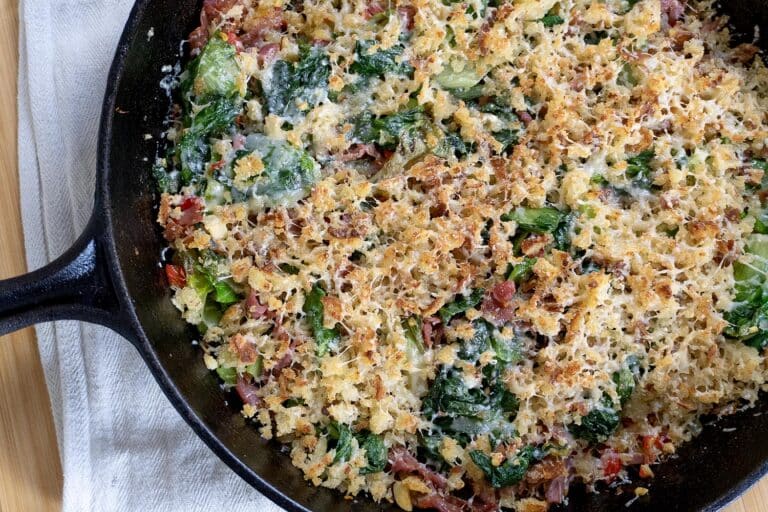
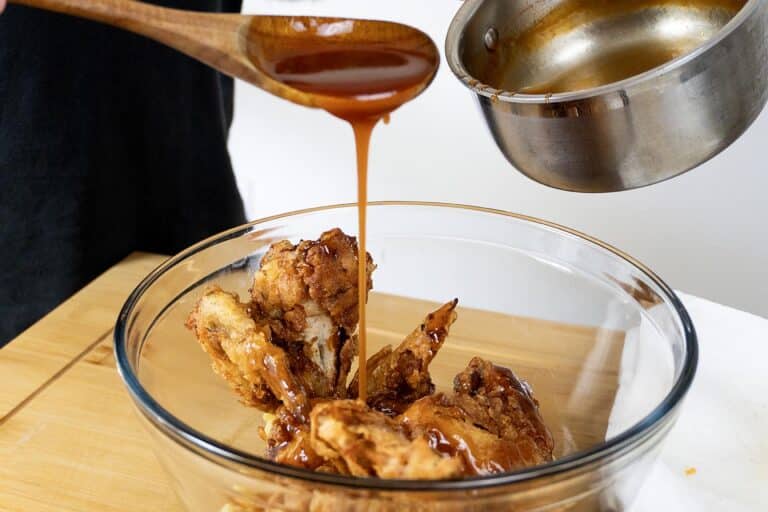
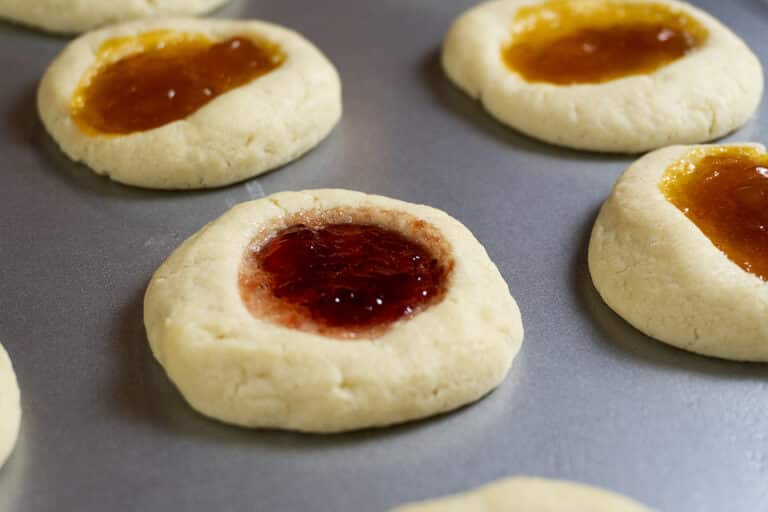
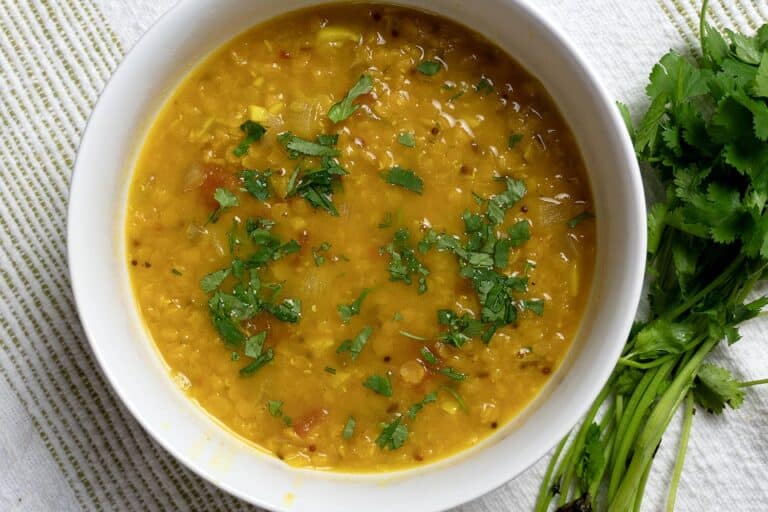
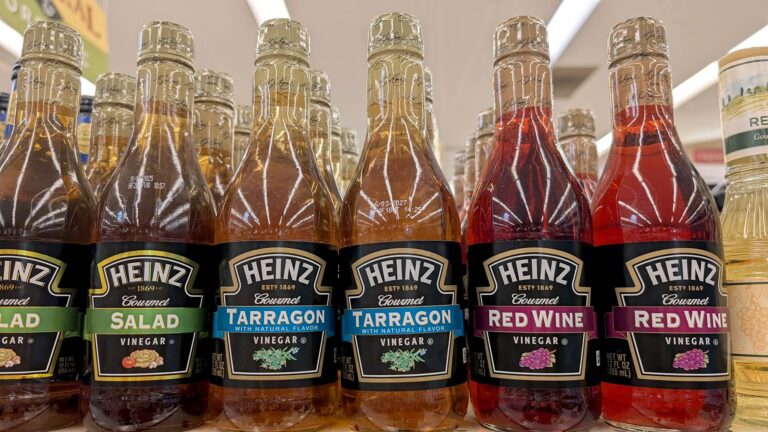
They look delicious. Do you not need to cook the veggies and meat before you stuff the dough?
I’m sure you could, but we don’t. We just make sure to cube the veggies small enough that they cook through. They go in the oven for 45 minutes, so it’s more than enough time to cook the vegetables through.